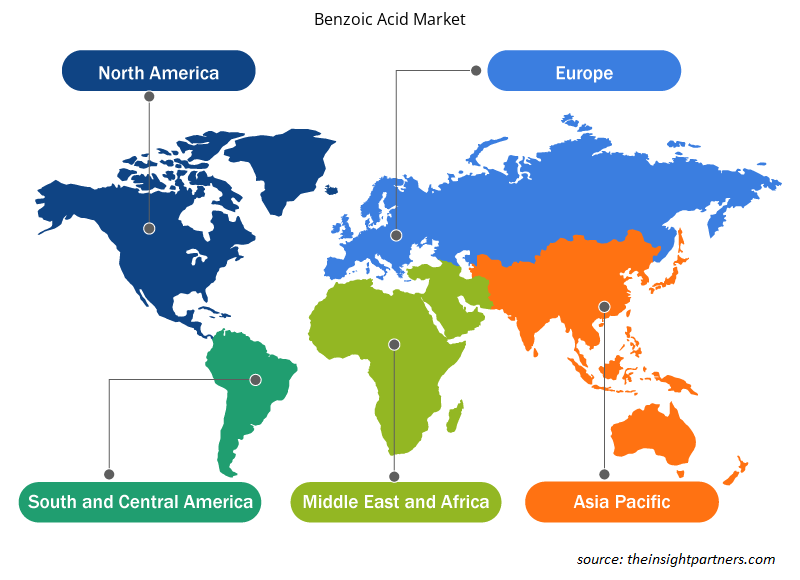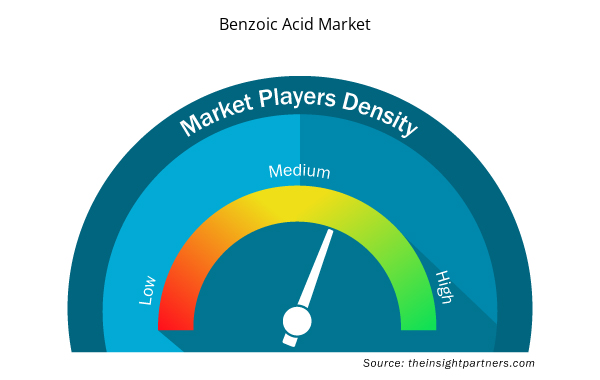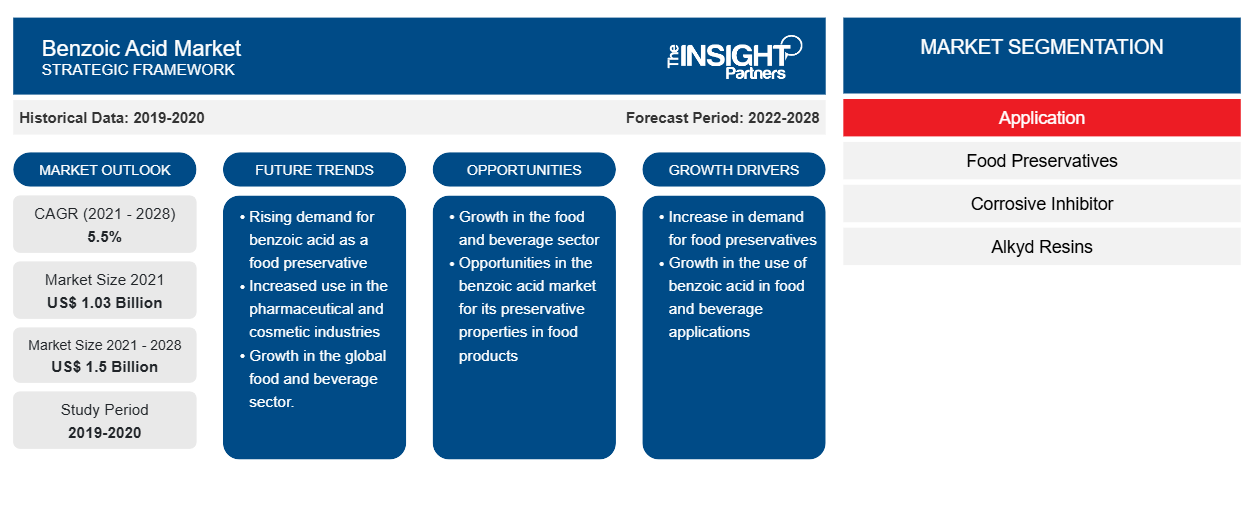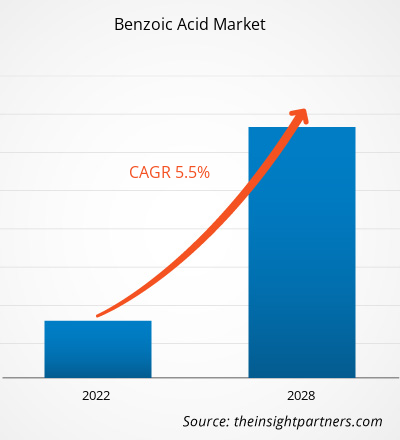[Forschungsbericht] Der Markt für Benzoesäure wurde im Jahr 2021 auf 1.028,07 Millionen US-Dollar geschätzt und soll bis 2028 1.496,54 Millionen US-Dollar erreichen; von 2021 bis 2028 wird ein durchschnittliches jährliches Wachstum von 5,5 % erwartet.
Benzoesäure ist ein häufig verwendetes antimikrobielles Konservierungsmittel in Getränken, insbesondere kohlensäurehaltigen Getränken. Darüber hinaus ist Natriumbenzoat ein weit verbreitetes Konservierungsmittel in Erfrischungsgetränken. Darüber hinaus verlagern sich die Verbraucherpräferenzen in verschiedenen Regionen wie Europa und Nordamerika hin zu Fertiggerichten und trinkfertigen Getränken, was die Nachfrage nach Benzoesäure ankurbelt. Das starke Wachstum in der Lebensmittel- und Getränkeindustrie und die steigende Nachfrage nach Konservierungsmitteln zur Verbesserung der Haltbarkeit der verschiedenen Lebensmittelprodukte tragen also zur starken Nachfrage nach Benzoesäure bei. Daher treibt die steigende Nachfrage nach Benzoesäure aus der Lebensmittel- und Getränkeindustrie das Wachstum des Benzoesäuremarktes an .
Darüber hinaus wird Benzoesäure häufig zur Herstellung vieler Chemikalien wie Benzoylchlorid und Benzoylperoxid verwendet, und Phenol wird zur Synthese von Benzoylchlorid verwendet. Darüber hinaus wird es zur Herstellung anderer Chemikalien, Farbstoffe, Parfüms, Herbizide und mehr verwendet. Darüber hinaus wird Benzoesäure am häufigsten zur Herstellung von Phenol verwendet. Phenole werden in Haushaltsreinigern und Mundwasser als Desinfektionsmittel verwendet. Die Nachfrage nach Benzoesäure steigt auch aufgrund der steigenden Nachfrage nach verschiedenen Chemikalien aus verschiedenen Anwendungsbereichen wie Benzoylchlorid, Benzoylperoxid und Phenol. Daher treibt die zunehmende Verwendung von Benzoesäure als Zwischenprodukt bei der Synthese verschiedener Produkte das Marktwachstum an.
Passen Sie diesen Bericht Ihren Anforderungen an
Sie erhalten kostenlos individuelle Anpassungen an jedem Bericht, einschließlich Teilen dieses Berichts oder einer Analyse auf Länderebene, eines Excel-Datenpakets sowie tolle Angebote und Rabatte für Start-ups und Universitäten.
- Holen Sie sich die wichtigsten Markttrends aus diesem Bericht.Dieses KOSTENLOSE Beispiel umfasst eine Datenanalyse von Markttrends bis hin zu Schätzungen und Prognosen.
Auswirkungen der COVID-19-Pandemie auf den Benzoesäuremarkt
Die COVID-19-Pandemie hat das Wachstum verschiedener Branchen weltweit erheblich gestört. Ebenso hatte die COVID-19-Pandemie im Jahr 2020 große Auswirkungen auf den Markt, als die Lieferkette des Rohstoffs für Biodünger aufgrund der Einschränkung des Warentransports beeinträchtigt wurde. Lockerungen der Lockdown-Maßnahmen in mehreren Ländern und der Anbau saisonaler Nutzpflanzen haben die weltweite Nachfrage nach Benzoesäure aufrechterhalten. Darüber hinaus kurbeln das schnelle COVID-19-Impfprogramm und die zunehmende Einführung des ökologischen Landbaus weltweit das Wachstum des Benzoesäuremarktes an, und die Hersteller von Benzoesäure verzeichnen ein deutliches Wachstum ihres Geschäfts.
Der globale Markt ist grob segmentiert in Nordamerika, Europa, Asien-Pazifik (APAC), Mittlerer Osten und Afrika (MEA) und Süd- und Mittelamerika (SAM). Der Markt in Nordamerika ist segmentiert in die USA, Kanada und Mexiko. Der Markt in dieser Region wird durch die zunehmende Verwendung dieser Verbindung als Lebensmittelkonservierungsmittel , Zwischenprodukt und Weichmacher angetrieben. Die florierende Lebensmittel- und Getränkeindustrie in der Region schafft eine enorme Nachfrage nach Lebensmittelkonservierungsmitteln, einschließlich Benzoesäure. Darüber hinaus ist die Chemieindustrie eine der größten Fertigungsindustrien in den USA; sie bedient sowohl inländische als auch ausländische Märkte. Die Chemieindustrie des Landes erzeugt eine enorme Nachfrage nach Benzoesäure als Zwischenprodukt für die Synthese verschiedener Chemikalien.
Markteinblicke
Das zunehmende Wachstum der Kosmetikindustrie eröffnet Chancen
Benzoesäure ist in vielen Produkten enthalten, beispielsweise in Parfüm, Lippenbalsam, Lippenstift, Gesichtsmasken, Mascara, Lidschatten und Make-up-Entferner. Darüber hinaus verwenden neben Frauen auch Männer immer mehr verschiedene Kosmetikprodukte im Alltag. Darüber hinaus konzentrieren sich Hersteller von Kosmetikprodukten auf Produktbranding, Werbung und Strategien zur Einführung neuer Produkte, um den Verkauf von Kosmetikprodukten zu steigern. Die oben genannten Faktoren tragen also zum starken Wachstum der Kosmetikindustrie bei.
Anwendungseinblicke
Basierend auf der Anwendung ist der globale Benzoesäuremarkt in Lebensmittelkonservierungsmittel, Korrosionsinhibitoren, Alkydharze, Synthesezwischenprodukte, Weichmacher, Futterzusätze und andere unterteilt. Das Segment der Synthesezwischenprodukte führte den globalen Benzoesäuremarkt im Jahr 2020 an. Benzoesäure wird auch als Zwischenprodukt für die Herstellung von Natriumbenzoat, Kaliumbenzoat, Benzoylchlorid und Benzotrichlorid verwendet, um nur einige zu nennen. Darüber hinaus wird es als Zwischenprodukt bei der Synthese von Farben, Lacken, Netzmitteln, Aromastoffen usw. eingesetzt. Das Wachstum der Automobil- und Bauindustrie führt unter anderem zu einer enormen Nachfrage nach Farben, was wiederum den Bedarf an Benzoesäure antreibt.
MERCK KGAA; LANXESS; SINTEZA; CHEMCRUX ENTERPRISES LTD; IG PETROCHEMICALS LTD; LIAONING HUAYI CHEMICAL INDUSTRY AND COMMERCE CO.,LTD.; TIANJIN DONGDA CHEMICAL GROUP CO., LTD; EASTMAN CHEMICAL COMPANY; FUSHIMI PHARMACEUTICAL CO., LTD.; und THE CHEMICAL COMPANY sind einige Akteure, die sich aktiv auf die Entwicklung innovativerer Benzoesäure für verschiedene Anwendungen konzentrieren.
Regionale Einblicke in den Benzoesäuremarkt
Die regionalen Trends und Faktoren, die den Benzoesäuremarkt im Prognosezeitraum beeinflussen, wurden von den Analysten von Insight Partners ausführlich erläutert. In diesem Abschnitt werden auch die Benzoesäuremarktsegmente und die Geografie in Nordamerika, Europa, im asiatisch-pazifischen Raum, im Nahen Osten und Afrika sowie in Süd- und Mittelamerika erörtert.

- Erhalten Sie regionale Daten zum Benzoesäuremarkt
Umfang des Marktberichts über Benzoesäure
| Berichtsattribut | Details |
|---|---|
| Marktgröße im Jahr 2021 | 1,03 Milliarden US-Dollar |
| Marktgröße bis 2028 | 1,5 Milliarden US-Dollar |
| Globale CAGR (2021 - 2028) | 5,5 % |
| Historische Daten | 2019-2020 |
| Prognosezeitraum | 2022–2028 |
| Abgedeckte Segmente | Nach Anwendung
|
| Abgedeckte Regionen und Länder | Nordamerika
|
| Marktführer und wichtige Unternehmensprofile |
|
Dichte der Akteure auf dem Benzoesäuremarkt: Deren Auswirkungen auf die Geschäftsdynamik verstehen
Der Markt für Benzoesäure wächst rasant, angetrieben durch die steigende Endverbrauchernachfrage aufgrund von Faktoren wie sich entwickelnden Verbraucherpräferenzen, technologischen Fortschritten und einem größeren Bewusstsein für die Vorteile des Produkts. Mit steigender Nachfrage erweitern Unternehmen ihr Angebot, entwickeln Innovationen, um die Bedürfnisse der Verbraucher zu erfüllen, und nutzen neue Trends, was das Marktwachstum weiter ankurbelt.
Die Marktteilnehmerdichte bezieht sich auf die Verteilung von Firmen oder Unternehmen, die in einem bestimmten Markt oder einer bestimmten Branche tätig sind. Sie gibt an, wie viele Wettbewerber (Marktteilnehmer) in einem bestimmten Marktraum im Verhältnis zu seiner Größe oder seinem gesamten Marktwert präsent sind.
Die wichtigsten auf dem Benzoesäuremarkt tätigen Unternehmen sind:
- Eastman Chemical Company
- Foodchem International Corporation
- AM Food Chemical Co., Limited
- OASIS FINE CHEM
- Spektrum Chemical
Haftungsausschluss : Die oben aufgeführten Unternehmen sind nicht in einer bestimmten Reihenfolge aufgeführt.

- Überblick über die wichtigsten Akteure auf dem Benzoesäuremarkt
Bericht-Spotlights
- Progressive Benzoic-Markttrends helfen den Akteuren bei der Entwicklung wirksamer langfristiger Strategien
- In Industrie- und Entwicklungsländern angewandte Strategien für Unternehmenswachstum
- Quantitative Analyse des Benzoesäuremarktes von 2019 bis 2028
- Schätzung der weltweiten Nachfrage nach Benzoesäure
- Porters Analyse zur Veranschaulichung der Wirksamkeit der in der Branche tätigen Käufer und Lieferanten
- Aktuelle Entwicklungen zum Verständnis des wettbewerbsorientierten Marktszenarios
- Markttrends und -aussichten sowie Faktoren, die das Wachstum des Benzoesäuremarktes vorantreiben und bremsen
- Unterstützung im Entscheidungsprozess durch Aufzeigen von Marktstrategien, die das kommerzielle Interesse untermauern und zum Marktwachstum führen
- Die Größe des Benzoesäuremarktes an verschiedenen Knotenpunkten
- Detaillierte Übersicht und Segmentierung des Marktes sowie der Dynamik der Benzoesäureindustrie
- Größe des Benzoesäuremarktes in verschiedenen Regionen mit vielversprechenden Wachstumschancen
- Historische Analyse (2 Jahre), Basisjahr, Prognose (7 Jahre) mit CAGR
- PEST- und SWOT-Analyse
- Marktgröße Wert/Volumen – Global, Regional, Land
- Branche und Wettbewerbsumfeld
- Excel-Datensatz



Report Coverage
Revenue forecast, Company Analysis, Industry landscape, Growth factors, and Trends

Segment Covered
This text is related
to segments covered.

Regional Scope
North America, Europe, Asia Pacific, Middle East & Africa, South & Central America

Country Scope
This text is related
to country scope.
Häufig gestellte Fragen
The global benzoic acid market is highly competitive owing to the presence of several regional and global players. Players compete with each other based on product quality and prices.
The global benzoic acid market is primarily driven by growing demand for benzoic acid from food & beverages industry and increasing use of benzoic acid as an intermediate in the synthesis of different products.
Asia Pacific is estimated to register the fastest CAGR in the global benzoic acid market over the forecast period. The increasing use of food preservatives in different products is highlighting the requirement for safe food preservatives in the region, which fuels the market for benzoic acid in the region.
The synthesis intermediates segment held the largest share of the global benzoic acid market in 2021. Benzoic acid is commonly used as a chemical intermediate for the synthesis of different chemicals. It is the most commonly used component in the production of phenol and caprolactam.
In 2021, Asia Pacific held the largest share of the global benzoic acid market. One of the major factors bolstering the benzoic acid market growth in Asia Pacific is the rise in demand for this substance in the food & beverages industry.
Major market players operating in the global benzoic acid market include Eastman Chemical Company; Foodchem International Corporation; A.M Food Chemical Co., Limited; OASIS FINE CHEM; Spectrum Chemical; LANXESS; Merck KGaA; Tianjin Dongda Chemical Group Co., Ltd; I G Petrochemicals Ltd. (IGPL); and Sinteza.
Trends and growth analysis reports related to Chemicals and Materials : READ MORE..
The List of Companies - Benzoic Acid Market
- Eastman Chemical Company
- Foodchem International Corporation
- A.M Food Chemical Co., Limited
- OASIS FINE CHEM
- Spectrum Chemical
- LANXESS
- Merck KGaA
- Tianjin Dongda Chemical Group Co., Ltd
- I G Petrochemicals Ltd. (IGPL)
- Sinteza
The Insight Partners performs research in 4 major stages: Data Collection & Secondary Research, Primary Research, Data Analysis and Data Triangulation & Final Review.
- Data Collection and Secondary Research:
As a market research and consulting firm operating from a decade, we have published and advised several client across the globe. First step for any study will start with an assessment of currently available data and insights from existing reports. Further, historical and current market information is collected from Investor Presentations, Annual Reports, SEC Filings, etc., and other information related to company’s performance and market positioning are gathered from Paid Databases (Factiva, Hoovers, and Reuters) and various other publications available in public domain.
Several associations trade associates, technical forums, institutes, societies and organization are accessed to gain technical as well as market related insights through their publications such as research papers, blogs and press releases related to the studies are referred to get cues about the market. Further, white papers, journals, magazines, and other news articles published in last 3 years are scrutinized and analyzed to understand the current market trends.
- Primary Research:
The primarily interview analysis comprise of data obtained from industry participants interview and answers to survey questions gathered by in-house primary team.
For primary research, interviews are conducted with industry experts/CEOs/Marketing Managers/VPs/Subject Matter Experts from both demand and supply side to get a 360-degree view of the market. The primary team conducts several interviews based on the complexity of the markets to understand the various market trends and dynamics which makes research more credible and precise.
A typical research interview fulfils the following functions:
- Provides first-hand information on the market size, market trends, growth trends, competitive landscape, and outlook
- Validates and strengthens in-house secondary research findings
- Develops the analysis team’s expertise and market understanding
Primary research involves email interactions and telephone interviews for each market, category, segment, and sub-segment across geographies. The participants who typically take part in such a process include, but are not limited to:
- Industry participants: VPs, business development managers, market intelligence managers and national sales managers
- Outside experts: Valuation experts, research analysts and key opinion leaders specializing in the electronics and semiconductor industry.
Below is the breakup of our primary respondents by company, designation, and region:

Once we receive the confirmation from primary research sources or primary respondents, we finalize the base year market estimation and forecast the data as per the macroeconomic and microeconomic factors assessed during data collection.
- Data Analysis:
Once data is validated through both secondary as well as primary respondents, we finalize the market estimations by hypothesis formulation and factor analysis at regional and country level.
- Macro-Economic Factor Analysis:
We analyse macroeconomic indicators such the gross domestic product (GDP), increase in the demand for goods and services across industries, technological advancement, regional economic growth, governmental policies, the influence of COVID-19, PEST analysis, and other aspects. This analysis aids in setting benchmarks for various nations/regions and approximating market splits. Additionally, the general trend of the aforementioned components aid in determining the market's development possibilities.
- Country Level Data:
Various factors that are especially aligned to the country are taken into account to determine the market size for a certain area and country, including the presence of vendors, such as headquarters and offices, the country's GDP, demand patterns, and industry growth. To comprehend the market dynamics for the nation, a number of growth variables, inhibitors, application areas, and current market trends are researched. The aforementioned elements aid in determining the country's overall market's growth potential.
- Company Profile:
The “Table of Contents” is formulated by listing and analyzing more than 25 - 30 companies operating in the market ecosystem across geographies. However, we profile only 10 companies as a standard practice in our syndicate reports. These 10 companies comprise leading, emerging, and regional players. Nonetheless, our analysis is not restricted to the 10 listed companies, we also analyze other companies present in the market to develop a holistic view and understand the prevailing trends. The “Company Profiles” section in the report covers key facts, business description, products & services, financial information, SWOT analysis, and key developments. The financial information presented is extracted from the annual reports and official documents of the publicly listed companies. Upon collecting the information for the sections of respective companies, we verify them via various primary sources and then compile the data in respective company profiles. The company level information helps us in deriving the base number as well as in forecasting the market size.
- Developing Base Number:
Aggregation of sales statistics (2020-2022) and macro-economic factor, and other secondary and primary research insights are utilized to arrive at base number and related market shares for 2022. The data gaps are identified in this step and relevant market data is analyzed, collected from paid primary interviews or databases. On finalizing the base year market size, forecasts are developed on the basis of macro-economic, industry and market growth factors and company level analysis.
- Data Triangulation and Final Review:
The market findings and base year market size calculations are validated from supply as well as demand side. Demand side validations are based on macro-economic factor analysis and benchmarks for respective regions and countries. In case of supply side validations, revenues of major companies are estimated (in case not available) based on industry benchmark, approximate number of employees, product portfolio, and primary interviews revenues are gathered. Further revenue from target product/service segment is assessed to avoid overshooting of market statistics. In case of heavy deviations between supply and demand side values, all thes steps are repeated to achieve synchronization.
We follow an iterative model, wherein we share our research findings with Subject Matter Experts (SME’s) and Key Opinion Leaders (KOLs) until consensus view of the market is not formulated – this model negates any drastic deviation in the opinions of experts. Only validated and universally acceptable research findings are quoted in our reports.
We have important check points that we use to validate our research findings – which we call – data triangulation, where we validate the information, we generate from secondary sources with primary interviews and then we re-validate with our internal data bases and Subject matter experts. This comprehensive model enables us to deliver high quality, reliable data in shortest possible time.


 Holen Sie sich ein kostenloses Muster für diesen Bericht
Holen Sie sich ein kostenloses Muster für diesen Bericht